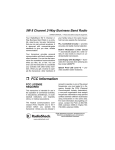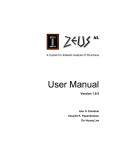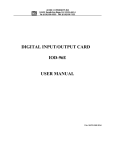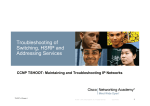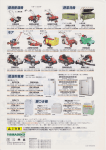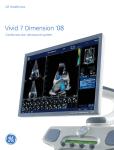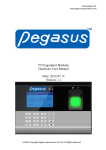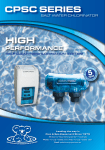Download MAD1 DMX Controller User Manual
Transcript
MAD1 DMX CONTROLLER USERS MANUAL ISSUE 5 INTRODUCTION Congratulations on purchasing your new controller. We have endeavoured to design quality and reliability to offer you an advanced Multi Media DMX-512 programmable controller that will give you optimal results at low budget. It is the most advanced unit for its size and price. We strongly recommend that you take time to read this manual fully before you attempt to use the controller. The controller is a dual microprocessor controlled system that is fully DMX-512 and MIDI compatible. The same controller can be used to control all present and future products in the range. All scenes, chases and programs can be selected and controlled from the easy-to-operate touch panel controller and each and every scene can be accessed and programmed via the MIDI interface. The controller also has a MIDI file recorder and player with MTC chase lock allowing for a complete fully automatic MIDI synchronized light show without the need for a MIDI sequencer. The controller is based on 10 banks on 6 DMX channels. It is possible to have a 4 channel scanner and a 2 channel colour changer on the same bank by using all six channels so a total of 10 colour changers with 10 scanners could be independently controlled. The Controller is designed to be used together with standard MIDI keyboards. It uses 2 MIDI channels out of the standard 16 and can be assigned to any address with the user DIP switches. It features 60 preprogrammed scenes, 12 preprogrammed chases, 60 programmable scenes and 12 programmable chases. The maximum number of steps per chase is 14. Sequences or individual scenes can be controlled using the front panel, or via a standard MIDI keyboard. The controller features a touch sensitive spill proof control panel, a proportional X/Y joystick normally used for pan and tilt, 4 linear sliders normally used for colour, gobo and two other effects plus a linear slider for chase speed. The construction is a standard 19” rack mount 2U unit with grab handles and power switch. On the rear panel there is a 3 pin XLR connector for DMX output, 1/4” Jack for Audio in, 2 x 5 pin DIN for MIDI IN and MIDI THRU. 120/240V selector combined IEC mains Inlet, a SMPTE socket (for future use) and the MIDI selector switches. Once again we would like to thank you for purchasing our controller and we are sure that it will provide you with easy operation and tremendous control power. SAFETY FIRST : LETHAL VOLTAGES EXIST INSIDE THE UNIT, REFER ALL SERVICING TO QUALIFIED PERSONNEL. CONTROLLER DESCRIPTION BLACKOUT : The BLACKOUT key will force all DMX channels to ‘0’ and will stop all programs and chases currently running. SCENE-CHASE-PROGRAM : This key selects the mode of operation between SCENES, when programming new scenes, CHASE, when programming a chase, and PROGRAM, when running a built in pre-program. CROSS FADE : This key, when activated, will create a cross fading effect between the steps in the program / chase that will result in very slow pan, tilt movement, and colour scroll SAVE : By pressing this key during scene programming the current state of all DMX channels can be repeatedly saved to a 40 year non volatile memory. This key is also used to save chases of scenes in chase mode and to enter midi file record in program mode. AUTO CHASE : This key will start an automatic continuous sequence of all the pre-programmed or user programmed chases. BANK SELECT : This key selects one of 10 banks of scenes or 1 of 2 banks of chases or 1 of 2 banks of pre-programs. The selected scene bank will show in the display as level 1 (L1) through level 9 (L9) and finally (LA). Chase banks show as (C0 , C1). Pre program banks show as (P0, P1). HEAD UP/DOWN : By pressing the UP or DOWN keys you can select the fixture you want to address. The ‘OP’ position selects every other fixture and the ‘AL’ selects all fixtures for multiple programming at one step. 1 - 6 Keys : During SCENE mode these keys will address the scene number you choose at the selected bank level (L1-LA). During CHASE mode these keys will select the chase you want to run. During PROGRAM mode they will select the built in pre-programs. CHASE SPEED : This slider will change the chase rate of the selected program/scene. At the minimum setting (0), the programs/scenes will become music activated and the music L.E.D (Light emitting diode) will flash at the rate of the audio bass beat. REAR PANEL DESCRIPTION 1 1234567- 2 3 4 5 IEC Mains Inlet with Combined fuse and 120\230 mains selector. The following connectors are SELV (Safe Extra Low Voltage) SPMTE input, phono socket. 1/4” Mono Jack Skt. Audio input. Female XLR DMX Output Connector. Midi Input Connector. Female 5 PIN 180 deg DIN. Midi Thru Connector. Male 5 PIN 180 deg DIN. MIDI Channel selector switches (4 dip sitches) XLR CONNECTOR Pin Configuration 1 Ground 2 DMX Neg (-) 3 DMX Pos (+) END TERMINATOR 100 Ohm resistor across pins 2 & 3 6 7 Sw1 0 1 0 1 0 1 0 1 0 1 0 1 0 1 0 1 Sw2 0 0 1 1 0 0 1 1 0 0 1 1 0 0 1 1 Midi Channel Selector Switch Dip Switch Configuration Sw3 Sw4 Pre Prog Channel 0 0 1 0 0 2 0 0 3 0 0 4 1 0 5 1 0 6 1 0 7 1 0 8 0 1 9 0 1 10 0 1 11 0 1 12 1 1 13 1 1 14 1 1 15 1 1 16 User Channel 2 3 4 5 6 7 8 9 10 11 12 13 14 15 16 1 INSTALLATION AND SET UP The controller can be interfaced directly to other Multi Media products such as music keyboards, foot switches and sequencers, via the 5 pin MIDI connectors at the back panel. The four DIP switches at the back panel set the MIDI channel you wish to use. There are 16 MIDI channels you can use and the controller requires 2 channels to control all its features. The channel that MIDI switch is set to, is used for cueing pre-programs and built in scenes. The MIDI channel + 1 is for cueing your own scenes and chases. To figure out the MIDI channel follow the binary sequence from 0000 to 1111 when SW1 is the LSB and SW4 is the MSB. Follow your MIDI instrument’s instruction on how to select and configure its MIDI interface channels. Note the controller must be switched off / on before new switch settings are read. SET UP POWER Your controller is able to operate on 120v or 230v 50/60hz. This is factory set and should only be altered by qualified service personnel. The voltage selected can be checked by looking at the unit with the earth pin at the top and noting which of the voltage ratings on the fuse holder is the correct way around to read. The controller should be installed so that the socket outlet is near the equipment and easily accessible. CAUTION :- Failure to operate at the correct voltage will result in serious damage to the unit! . FIXTURE DMX SWITCH SETTINGS: The controller is factory programmed with 60 scenes and 12 chases. These scenes and chases can be accessed by a midi input and the chases only can be run from the front panel. The DMX address table following gives the ideal setup to make best use of these, of course, not all effects have to be used. HEAD SCAN411 1 2 3 4 5 6 7 8 9 10 c001 c007 c013 c019 QSCAN/ COL211 SCAN611ARP c003 c009 c015 c021 c025 c031 c037 c043 QCOL STAR311/QSTAR/ SATR511ARP c027 c033 c039 c043 c050 c056 OPERATION AND PROGRAMMING MODES OF OPERATION Your controller has three basic modes of operation selected from the SCENE-CHASE-PROGRAM key: Scene: This mode should be selected when you intend to create new scenes. Press the function key until the ‘scene’ indicator is lit. See the ‘Operation and Programming’ section for programming procedures. Chase: This mode should be selected after you have stored several scenes and you like to create a chase. Press the function key until the ‘chase’ indicator is lit. See the ‘Operation and Programming’ section for more details. Program: In this mode you can run the pre-programmed chases by pressing one of the number keys on the control panel touch pad. Access this mode by pressing the function key until the ‘program’ indicator is lit. When you turn on the controller for the first time the display will read ‘P’ for program, and you will be in the ‘program’ mode. You can also enter midi file record mode by pressing the SAVE key. Note the PRE programs are optimised for use as detailed in the DMX settings table. RUNNING A PROGRAM When your controller is first switched on, the display BLACK OUT indicator will light and the ‘program’ indicator will be on. You are now in the program mode and you can select any one of the six built in pre-programs by pressing one of the number keys (1-6) on the control panel. Now press the BLACK OUT touch pad to turn on the lights. There are five sliders and a joystick on the controller as follows: DMX CH2 DMX CH1 CHASE SPEED DMX CH3 DMX CH4 DMX CH5 DMX CH6 To adjust the chase speed use the ‘CHASE SPEED’ slider while the program is running. When the slider is at the minimum (‘0’) position the controller will become sound activated and you will notice the sound L.E.D ( ¶ ) flashing to the beat of the music. Pressing the CROSS FADE key will create a ‘smoother’ effect. Pressing the AUTO CHASE key will start the automatic sequence where all the pre-programs will chase continuously. Pressing the BLACK OUT key again will stop the program and will turn off the lights. CREATING A SCENE (stage 1) The controller is capable of 60 programmable scenes and the first step before any program can be entered is to create several scenes. Follow the procedure below to create a scene. Press the function key until the scene indicator is lit: Select the head you want to address with the HEAD UP & HEAD DOWN keys. After you view the unit number in the display window go ahead and adjust the DMX channels using the slider and joystick levels to the desired level. * Note: It is important to move the sliders upwards until they engage and activate the function. Repeat the above for each head. The current head will be displayed in the display window. For quick programming you can select ‘AL’ or ‘OP’ . ‘AL’ will move all the heads in the same direction. ‘OP’ will move every other head in an opposite direction. Use the ‘HEAD UP’ or ‘HEAD DOWN’ keys until the display shows ‘AL’ or ‘OP’. SAVING A SCENE (stage 2) After you adjust all the parameters, to save the scene press the SAVE key. When you notice all the number L.E.D’s flashing, select one of the six numbered touch pads (see above) to store the scene you created. If you selected number one (1), the scene will be stored as scene number one (1) in the currently selected scene bank (L1 - L9 and LA). When you are in scene bank one (1) you will note the display flashes L1 When you use all six scenes at this bank you can select another bank with the BANK SELECT key where you have another six scenes. The display will then show L2 and each succesive press will increment the banks. Note: Alternatively you can press the key on the midi keyboard to where you want to save the scene. ! There is a total of 10 levels (60 scenes). Repeat stages 1 and 2 to create more scenes ! It is recommended that you fill the ‘Memory Map’ on the next page to remind you of ‘looks’ you created and serve as a reference during programming. MEMORY MAP 1 L1 L2 L3 L4 L5 L6 L7 L8 L9 LA 2 3 4 5 6 CREATING AND SAVING CHASE Press the function key until the chase indicator is lit Press the BANK SELECT key to select the chase bank to where you want to save the chase.(C0 to C1). You do not need to do this if you have a midi keyboard. Press the SAVE key. All the L.E.D’s will flash. Press one of the six number keys 1 to 6 to select a chase number or press the key on the midi keyboards where you wish to save the chase (TOP 12 keys). Press one of the six number keys 1 to 6 along with the BANK SELECT key to select the scenes you want to include in this chase and in the order you want. (MAX. 14). Or press the scene keys on the midi keyboard. Press the SAVE key when done and the chase will run. As with the pre-programs the chase speed may be varied and the ‘CROSS FADE’ can be used. The desired speed may be saved with the chase by pressing the ‘SAVE’ key again. ! There are a total of six chases. ! Repeat stage three (3) again to create another chase. When you have finished creating scenes and chases it is advisable that you protect your data by locking the memory of the controller. You can lock/unlock the memory by pressing ‘BLACK OUT’ followed by the number pad: 6 + 6 + 6 (Save Light lit = locked ). MIDI AND MULTI MEDIA Your controller can interface directly to other Multi Media products via the 5 pin MIDI connectors. It can be used in conjunction with music keyboards, foot switches and sequencers such as Enigma and Cubase. A sequencer is only required for complex editing of a lightshow. This lightshow can then be recorder by the controller and the sequencer is not required any more. For simple lightshows, a sequencer is not required at all. The design of the controller scenes and chases fit perfectly to a standard 49 key MIDI keyboard such as GMK49 or Roland PC100. On these keyboards the first 5 octaves of the keyboard (the first 60 notes) will access directly the 60 scenes, the next octave (61 - 72) will activate the chases. The last key (73) controls the ‘Black Out’. (Note transpose UP and DOWN on the midi keyboard is used to make the 4 octave keyboard cover 6 octaves). A keyboard can operate up to 8 different Controllers addressed on different MIDI channels. Set the MIDI switches to the MIDI channel you wish to use (Refer to the keyboard manual). The channel that MIDI switch is set to, is used for cueing pre-programs and built in scenes. The MIDI channel + 1 is for cueing your own scenes and chases. To put the controller into MIDI file record, simply press the SCENE-CHASE-PROGRAM key to PROGRAM and press the SAVE key. When the controller sees the MIDI TIME CODE via the MIDI IN port, it will lock to it, (NOTE only 1st 8 mins of MTC are allowed). The controller will finish the record when the MTC signal is stopped. To play the MIDI file back, simply start the MTC source up again and the controller will lock to it. Following is a simple set up for a light show. One of the audio tracks is used as a time code track. The TS1 can be used to record this onto the 4 track tape player before the audio is recorded onto the 4 track. The TS1 converts the audio SPMTE onto the tape to MTC for the controller. When the controller is in midi file record mode, just hit the required midi notes on the midi keyboard in time with the music and the controller will record them relative to the time position. TROUBLE SHOOTING FAULT CHECK Fixture does not turn on Check power line Fixture does not respond to DMX signal Check the control cable from the controller and along the chain. Look for bad connection, bad cable or incorrect wiring. Check the addressing and personality DIP switches on the back panel. Make sure the unit is set up and addressed properly and according to the table. The controller does not respond to the MIDI. Make sure that your MIDI instrument corresponds to the right MIDI channel you selected via the DIP switches at the controller back panel. Consult your MIDI instrument manual on how to select your MIDI channel. The controller does not store your scene/chase. Unlock the memory by pressing ‘BLACK OUT’ followed by the number pad ‘6’ + ‘6’ + ‘6’. After you have entered your scenes, lock the memory again using the same sequence. TECHNICAL Power Consumption: <0.2 Amp @ 120V & 230V Operating Voltages: User selectable via 120/230V selector switch from back panel. Fuse : Internal on PCB 1 x T-250VAC-500mA 20mm GLASS Mains within in IEC inlet 1 x T-250VAC-100mA 20mm CERAMIC. Connectors: 1/4” mono Jack for Audio in. (SELV) 2 x 180 deg 5 pin din for MIDI IN and MIDI THRU (SELV) 1 x XLR skt for DMX out (SELV) IEC fused mains inlet with 120\230V selector switch 1x phono socket for SMPTE input (SELV) Control Protocol : Industry standard 1990/91 version DMX 512. MIDI Interface: MIDI IN and MIDI THRU interface for operation via standard keyboard, Midi foot switch, Sequencer, MTC source. Implements the following :Midi Note on Midi Progam change. Midi time code chase lock, first 8 miniutes. Size: 19” Rack mount with rear box 17” x 5” x 3.25” Weight: 1.5Kg Scenes: 60 programmable, 60 pre programmed. Chases: 12 Programmable, 12 pre programmed. Audio: Line voltage 1V Pk to Pk to 3V Pk to Pk. Memory: 40 Year. No battery required. Due to continuous improvements, specifications may change without prior notice. SELV = Safety Extra Low Voltage GUARANTEE Mad Lighting Ltd guarantee the controller to the original purchaser to be free from defects in workmanship or materials for a period of 2 years in the UK and 1 year in other countries from the date of purchase provided the registration slip is returned within 14 days of purchase. This guarantee covers parts and labour. Proof of purchase must be provided by you for all guarantee repairs. This will usually be in the form of a dated receipt. In cases where no proof of purchase exists, date of manufacture will be used to determine the commencement of the guarantee period. The guarantee does not cover any damages created through accident, miss-use, abuse, neglect, improper installation or alteration other than by Mad Lighting Ltd or its authorised representatives. Mad Lighting Ltd is not responsible for damages or loss during shipment. Repair or replacement will be made at the option of Mad Lighting Ltd. Mad Lighting Ltd or its agents will not be liable for any incidental or consequential damages for breach of any express or implied guarantee on this product. Except to the extent prohibited by applicable law, any implied guarantee of merchantability or fitness for a particular purpose on this product is limited to the duration of this guarantee. Shipping for Repair Never return a piece of equipment for repair until you have obtained a ‘Return Authorisation Number’ (RA #) from your dealer or distributor. Returned equipment will not be accepted without this. Shipping costs are the purchasers responsibility. Mad Lighting Ltd will cover one way shipping costs for guarantee repairs within Europe. Never ship returns to us freight collect. Expedited deliveries are not covered under Guarantee. GUARANTEE REGISTRATION SLIP. SERIAL NO. __________ SUPPLIED BY : ADDRESS : DATE PURCHASED ________ YOUR NAME ADDRESS: TO BE RETURNED WITHIN 14 DAYS OF PURCHASE.











